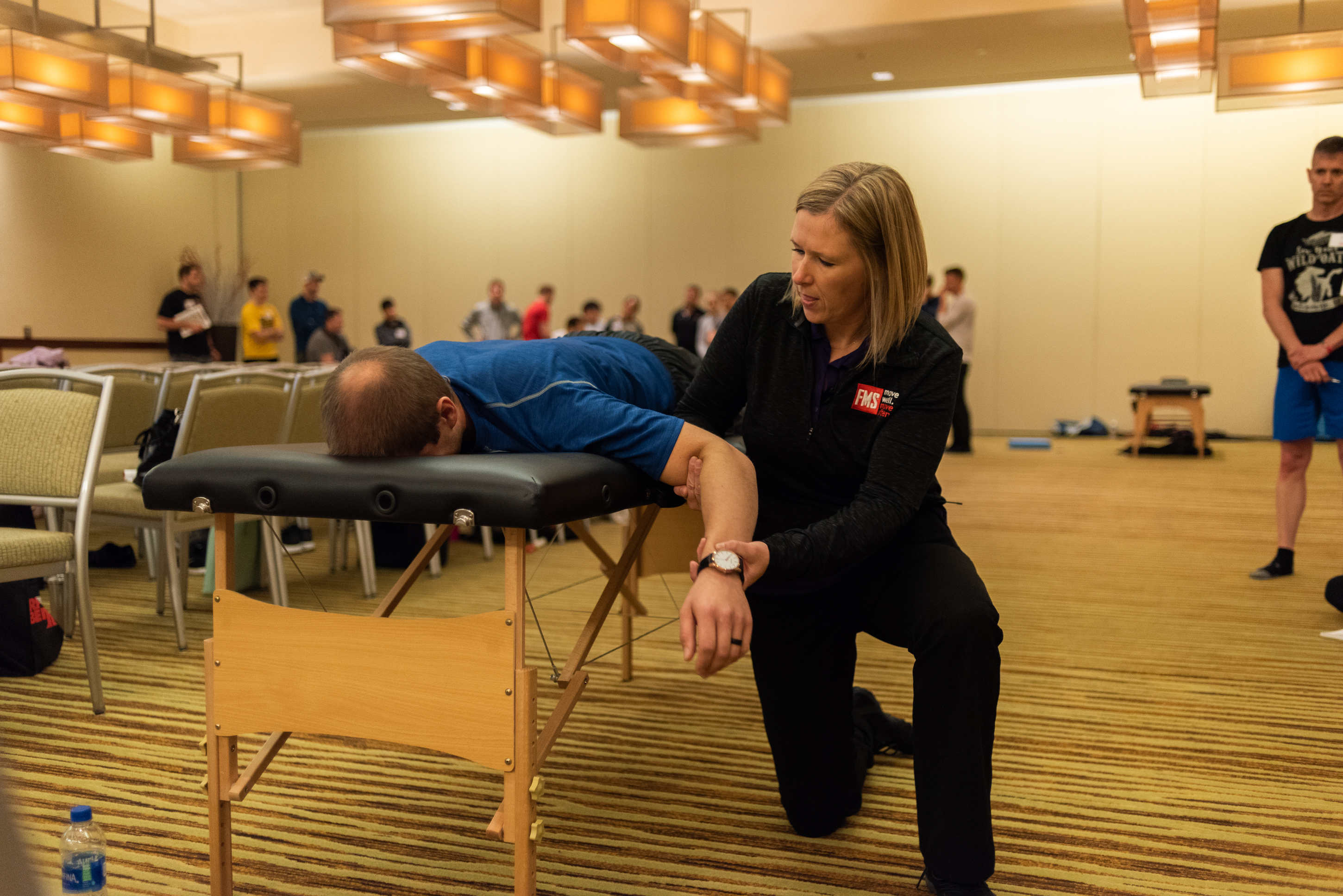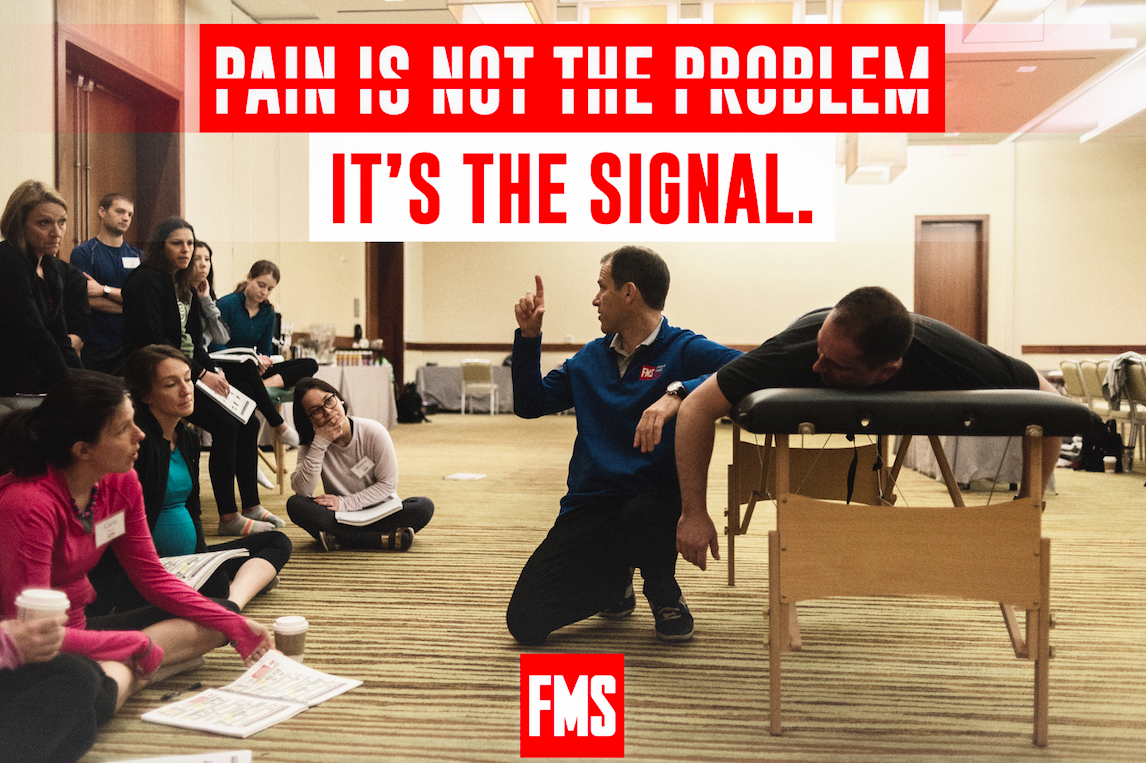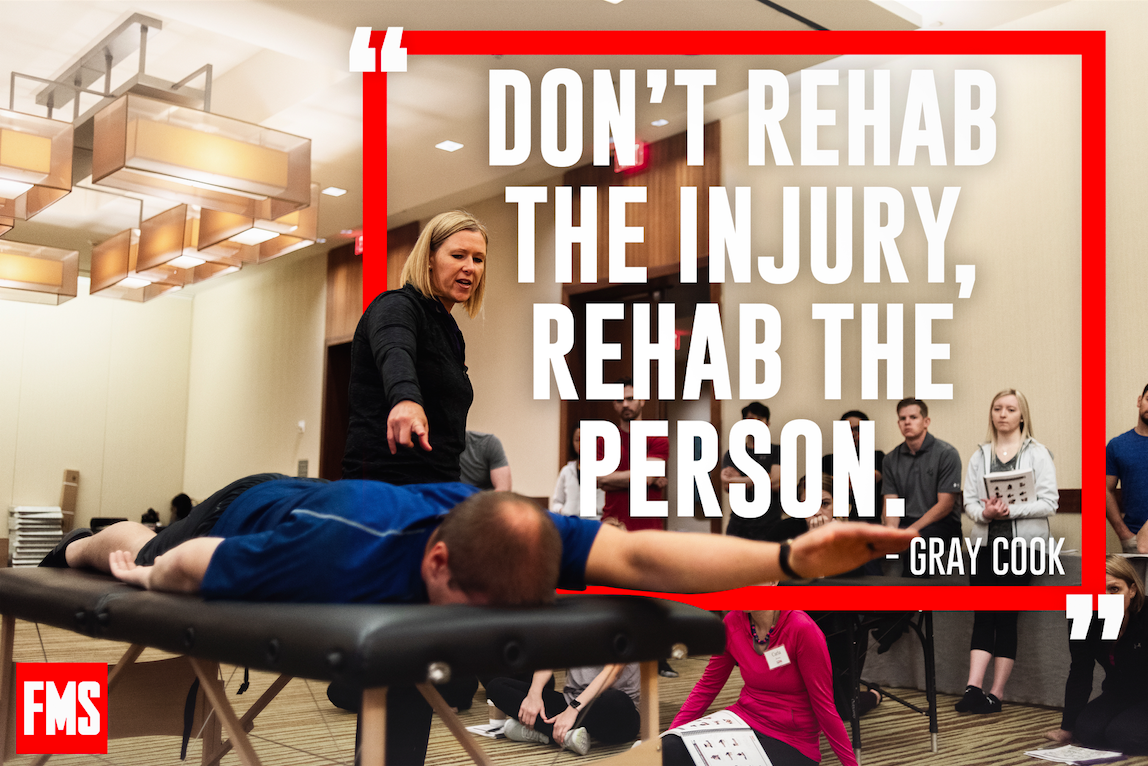What To Expect in SFMA Level 1 & 2
Posted by FMS

One of the reasons why I use the SFMA in clinical practice is that it sets the movement baseline for you. The standard of treatment patients receive isn’t governed by whether I am having a “good” or “bad” day. The standard is set and if I can move my patient closer to that standard, then my job is done. Not just in a feel good, fuzzy kind of way but rather a measurable change that creates lasting benefits for more patients.
By having a standard, it also forces me to look beyond the obvious and consider aspects of a patient’s presenting complaint that might otherwise be all too easy to ignore.
Let me give you a recent example to show you how this works in clinical practice. A patient that I had not seen in quite some time, attended my clinic a few weeks ago. Let’s call her Tina.
Tina is 57 years old, fitter, stronger and moves better than most of my patients who are 20 years younger!
Tina’s presentation initially involved pain in the left lower posterior lateral ribs that came on when putting on her stockings, the pain settled, then a few days later occurred again when moving a heavy bag of dog food. Shortly after that, Tina twisted to the right when seated, got a sharp pain in the lower back and soon after pins and needles down the right posterior thigh. This all occurred 2 months prior to coming to see me. The pain in the left ribs had mostly settled but the pain in the lower back was still quite bad.
Her GP ordered an MRI that showed degeneration at the L4/5 disc with an annular fissure and mild stenosis of the right foramen. This at least explained the lower back and right leg symptoms.
A quick systems check for any other health problems since her last visit over a year ago, had Tina report that until this current injury she had been going really well but had been diagnosed as a celiac. Adjusting to a new diet had been difficult but she feels much better since she had.
Prior to her visit to my clinic, Tina had received treatment consisting of manipulations at the lumbar spine. This had settled the acute pain but Tina still had pain standing and could not get back to her usual exercise routine. Another practitioner had mobilized her sacro-iliac joints with no further resolution of the existing symptoms.
There was significant tenderness on posterior to anterior palpation over the L4/5 joint complex including associated erector spinae muscle spasm. Motion testing also indicated mobility restrictions. Believe me when I say that regardless of how you perform your local biomechanical testing, any and all of us would agree that the L4/5 joint complex was clearly in trouble.
But was it the “victim” or the “villain”? Was the L4/5 joint complex the source of the pain or the cause of the problem.

I ask you – would you do more manipulation to the L4/5 with this patient presentation?
This patient had already seen another practitioner who is very experienced in spinal manipulation, has had several treatments and manipulation had not fully resolved the patient’s symptoms. Are your joint manipulations really that much better than another experienced manipulator?? I am not going to assume that mine are. So based on this reasoning, I couldn’t see any point in just more manipulation to the area.
Thankfully I routinely use the SFMA in my clinical practice to be able to dig deeper and do more investigative work. So by the time I had come to my local biomechanical exam of the L4/5 joint complex, I had already completed my SFMA. It was the results of the SFMA that already had my brain outside the L4/5 boxed in thinking.
FN
MSF -bilateral single leg
DP
MSE
MSR L
DN
All Cervical patterns
Bilateral LRF
MSR R
Squat
Mobility Restrictions
Right tibial rotation
Right Thoracic rotation/extension
Right>Left FABERE
Right deep hip
Right>Left rectus femoris
Right>Left hip external rotation (both seated 90º and prone neutral)
Bilateral external rotation
Right shoulder flexion
Bilateral bent knee dorsiflexion
Cervical upper/lower flexion & rotation, extension
SMCDs
Bilateral eversion
Left spine rotation/extension
Any of you who have taken the SFMA know that the mechanics of the SFMA primarily involve breaking down dysfunctional patterns of global movement to a regional functional diagnosis. We then categorize these dysfunctions further into mobility or stability motor control dysfunctions.
However, it’s still a palpatory experience and performing the mechanics of the SFMA should alert you to areas that feel worse and more significant than others. Paying more attention, you can start to feel where one dysfunction overlaps with others and even which dysfunctions might be “driving” the problem.
The drag I could feel deep in the anterior torso kept jumping out at me during the entire SFMA. Go back and take a look at those findings, “something” was causing marked dysfunctional findings affecting the right hip and the right spinal rotation and extension. A quick local biomechanical exam made it clear that it wasn’t the right hip joint.
After you have performed an SFMA, take a moment to put the picture together. The point of the SFMA and the underlying local biomechanical exams are not necessarily to have you treat every single mobility and motor control problem that you find. Rather, try to find the common thread, the thing that links everything together.
This is what I like most about using the SFMA. The SFMA clearly showed me that despite manipulation to the L4/5 joint complex, there were still issues with global movement patterns and the functional diagnosis from the breakouts revealed several possible points of entry to this problem.
It just seemed odd to me that someone with an annular tear at the L4/5 would have a functional and non-painful multi-segmental flexion pattern. In my experience at least, this is rare. We could put this down to the chiropractic adjustments that had already occurred prior to the visit with me. However as already mentioned, the L4/5 joint complex was certainly still in trouble.
If we go back to the history we find that there has been a significant irritation to the gastrointestinal tract over the past year. MSE and left MSR were causing pain. The GI tract has smooth muscle fibres rather that striated fibres but at the end of the day, they are still contractile fibres. So my local biomechanical exam moved to the GI tract. Surprise, surprise, the ascending colon was in spasm and acutely painful on palpation. The ascending colon firmly attaches to the posterior abdominal wall, so its not surprising that a spasm here will affect lumbar spine mechanics. Especially at a joint complex that is already compromised.
Clearly, manipulation at the L4/5 had not cleared up the problem at the ascending colon. So we ran a little experiment – instead of treating the L4/5 joint complex, we would treat the large intestine first and see what affect this had on the L4/5. A “reset” visceral technique was directed at the ascending colon and was extended to the splenic flexure of the colon.
This not only markedly reduced the tenderness and dysfunction at the L4/5 joint complex but also dramatically improved the SFMA top tier, resulting in a non-painful MSE and left MSR patterns.
Continuing along the large intestine to the splenic flexure, also fully resolved Tina’s residual pain at the left side lower posterior/lateral rib cage.
Further reset techniques were performed to the L4/5 joint complex. These further reduced the pain but another retest of the top tier showed no significant gains in movement pattern quality, or range of motion.
In other words, the L4/5 joint complex was the “victim” and causing the pain but the colon was the “villain”, the true cause of the problem.

This also explains why the initial symptoms started at the left lower posterior/lateral ribs. The same structure was causing the problem. It just started in a different location - the splenic flexure.
Do you need more proof that the body is a unit and not just a collection of parts? With no direct treatment, cervical range of motion improved. This was likely a result of the reduced irritation being carried by the Vagus nerve. There was also an incidental finding from the SFMA - a reduced right straight knee dorsi-flexion at the ankle during the tandem stance assessment. This was an incidental finding as single leg stance was functional and non painful bilaterally. We just measured this as part of the tandem stance assessment because we were already there and doing the bent knee dorsi flexion as part of the squat breakout. Passive testing indicated that these were mobility restrictions. These dysfunctions fully resolved after treating the colon despite the fact that absolutely no reset techniques were specifically directed towards improving ankle dorsi-flexion.
After a few treatments, Tina has returned to full normal daily activities and has no pain on any SFMA top tier movements. We plan an FMS soon and a return to exercises based on the results.
 Rod is a practicing Osteopath in Australia. He has a broad range of experience treating a wide variety of patients from general populations to professional athletes. It was Rod's background in mixed martial arts that had him look more closely at how fundamental human movement underpins elite athletic performance. Rod uses the complete Functional Movement Systems approach in daily Osteopathic practice, performance
Rod is a practicing Osteopath in Australia. He has a broad range of experience treating a wide variety of patients from general populations to professional athletes. It was Rod's background in mixed martial arts that had him look more closely at how fundamental human movement underpins elite athletic performance. Rod uses the complete Functional Movement Systems approach in daily Osteopathic practice, performance Posted by FMS
nice work up. thanks for sharing.
Nice one, I always felt like SFMA is very much inline with the Osteopathic philosophy. Thanks for sharing. Is there a specific method you use for the colon reset?